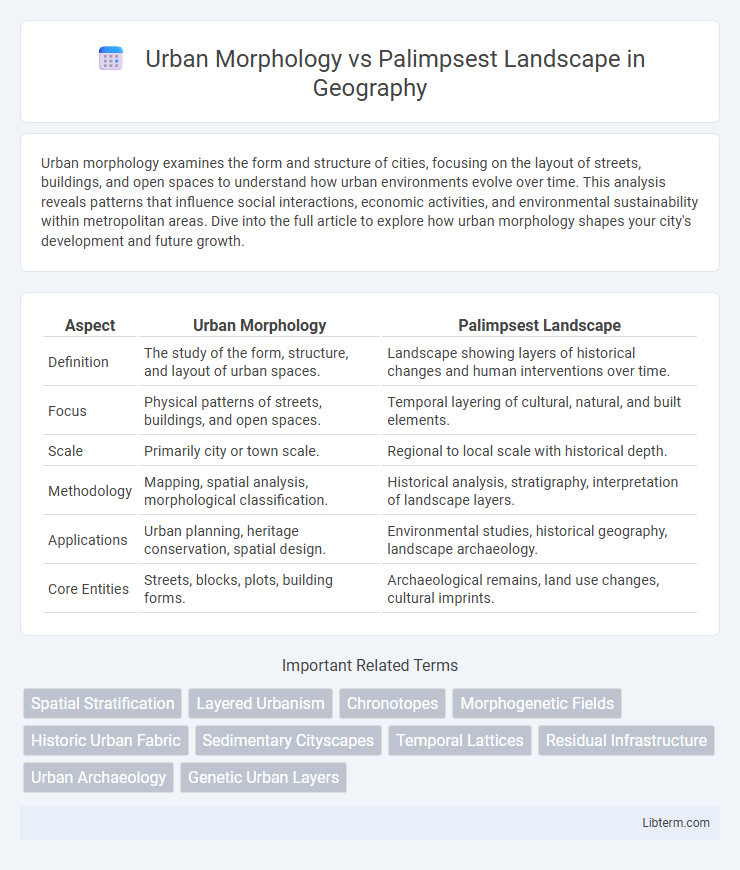Urban morphology examines the form and structure of cities, focusing on the layout of streets, buildings, and open spaces to understand how urban environments evolve over time. This analysis reveals patterns that influence social interactions, economic activities, and environmental sustainability within metropolitan areas. Dive into the full article to explore how urban morphology shapes your city's development and future growth.
Table of Comparison
| Aspect | Urban Morphology | Palimpsest Landscape |
|---|---|---|
| Definition | The study of the form, structure, and layout of urban spaces. | Landscape showing layers of historical changes and human interventions over time. |
| Focus | Physical patterns of streets, buildings, and open spaces. | Temporal layering of cultural, natural, and built elements. |
| Scale | Primarily city or town scale. | Regional to local scale with historical depth. |
| Methodology | Mapping, spatial analysis, morphological classification. | Historical analysis, stratigraphy, interpretation of landscape layers. |
| Applications | Urban planning, heritage conservation, spatial design. | Environmental studies, historical geography, landscape archaeology. |
| Core Entities | Streets, blocks, plots, building forms. | Archaeological remains, land use changes, cultural imprints. |
Understanding Urban Morphology: Definition and Scope
Urban morphology examines the physical form, structure, and layout of urban spaces, analyzing patterns of streets, buildings, and open areas to understand city development and spatial organization. It encompasses land use, architectural styles, and historical growth, providing insights into how urban environments evolve over time. The concept contrasts with palimpsest landscapes, where layers of historical interventions overlap, revealing the complex, multi-temporal fabric of cities.
What is a Palimpsest Landscape?
A Palimpsest Landscape refers to an environment where multiple layers of historical, cultural, and natural features coexist, reflecting successive phases of human intervention and ecological change. Unlike typical urban morphology that analyzes the current urban form and structure, palimpsest landscapes reveal a complex tapestry of past and present elements preserved over time in the spatial arrangement. This concept emphasizes the importance of reading the landscape as a dynamic archive to understand urban development processes and heritage conservation.
Comparative Foundations: Urban Morphology vs. Palimpsest Landscape
Urban morphology analyzes the physical layout and structure of cities through components like street patterns, building forms, and land use over time, focusing on spatial organization and growth processes. Palimpsest landscape emphasizes the layered historical imprints visible in urban environments, highlighting how past socio-cultural, architectural, and environmental elements coexist and interact within contemporary cityscapes. Comparative foundations reveal urban morphology as a structural and functional study, whereas palimpsest landscape offers a temporal and interpretive perspective on urban evolution and memory embedded in place.
Historical Evolution of Cities Through Morphological Lenses
Urban morphology examines the structural formation and spatial patterns of cities, highlighting the layering of physical and social elements over time. A palimpsest landscape reveals the historical evolution of urban spaces through visible traces of past developments, offering a tangible record of change and continuity. Studying cities via these morphological lenses uncovers the dynamic interplay between growth, adaptation, and cultural memory embedded in the urban fabric.
The Layered City: Tracing Palimpsest in Urban Landscapes
The Layered City concept emphasizes the analysis of palimpsest landscapes, where multiple historical urban layers overlap and interact, revealing complex patterns of urban morphology. Tracing these layers uncovers the evolution of spatial forms, infrastructure, and architectural styles embedded in contemporary cityscapes, highlighting the persistence of past urban footprints despite ongoing transformations. Understanding this dynamic interplay between old and new urban fabrics enhances insights into sustainable urban regeneration and heritage conservation strategies.
Methodological Approaches in Urban Morphology Analysis
Urban morphology analysis employs techniques such as spatial syntax, morphogenetic studies, and historic-geographical mapping to understand city structure and evolution. Palimpsest landscape approaches emphasize layering and temporal transformations, using stratigraphic methods and archival data to reveal multifaceted urban histories. Integrating GIS technologies and 3D modeling enhances both methodologies by providing precise spatial analysis and visualization of urban form changes over time.
Reading the Layers: Techniques in Palimpsest Landscape Interpretation
Urban morphology analyzes the formation and transformation of city structures by studying spatial patterns, street layouts, and building typologies. Palimpsest landscape interpretation employs techniques such as historical mapping, stratigraphic analysis, and geospatial technologies to uncover overlapping temporal layers within the urban fabric. These methods reveal the evolution of land use and human activities, enabling a nuanced understanding of how past urban imprints coexist and influence present landscapes.
Case Studies: Cities as Morphological and Palimpsest Examples
Urban morphology examines the spatial structure and form of cities, analyzing patterns such as street layouts, building typologies, and land use evolution. Palimpsest landscapes reveal how historical layers of urban development coexist, where older structures and designs are partially erased and overwritten by new interventions, reflecting temporal complexity. Cities like Rome and Istanbul serve as prominent case studies, demonstrating intricate morphological patterns intertwined with palimpsestic layers of cultural, social, and architectural transformations over centuries.
Implications for Urban Planning and Heritage Conservation
Urban morphology analyzes the form and structure of urban spaces, providing insights into patterns of streets, plots, and buildings that inform efficient spatial planning and infrastructure development. Palimpsest landscapes reveal layers of historical and cultural transformations in urban environments, emphasizing the need to preserve heritage elements while accommodating contemporary growth. Integrating both approaches enables urban planners to balance modernization with conservation, promoting sustainable development that respects historical identity and spatial complexity.
Bridging Morphology and Palimpsest: Toward Integrated Urban Analysis
Bridging Urban Morphology and Palimpsest Landscape enables a comprehensive analysis of urban spaces by integrating spatial structure with historical layering. This approach reveals how urban form evolves through cumulative transformations, highlighting patterns of continuity and change in city development. Integrating morphological analysis with palimpsest theory supports adaptive urban planning that respects heritage while accommodating contemporary needs.
Urban Morphology Infographic

 libterm.com
libterm.com